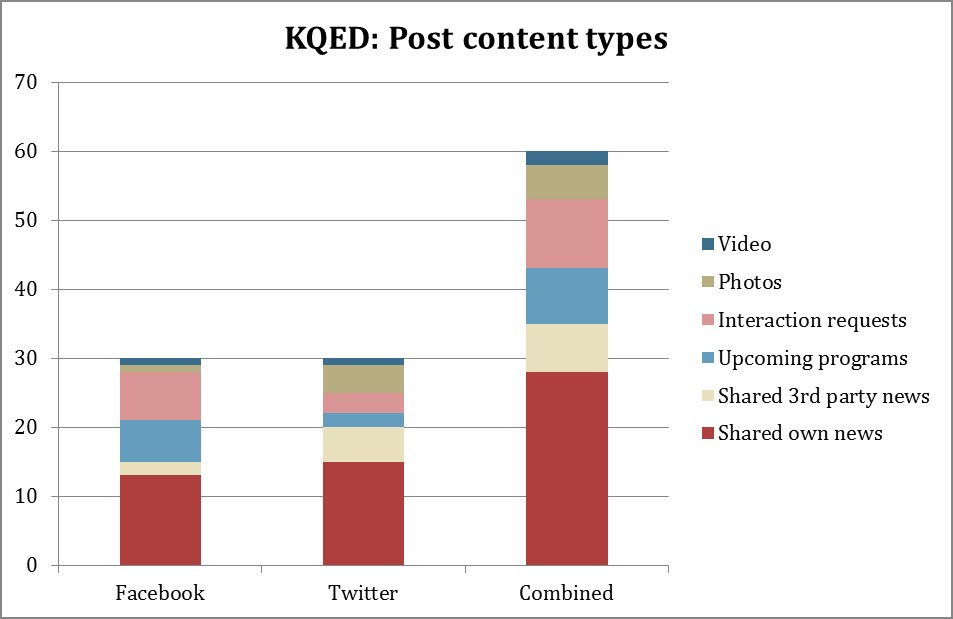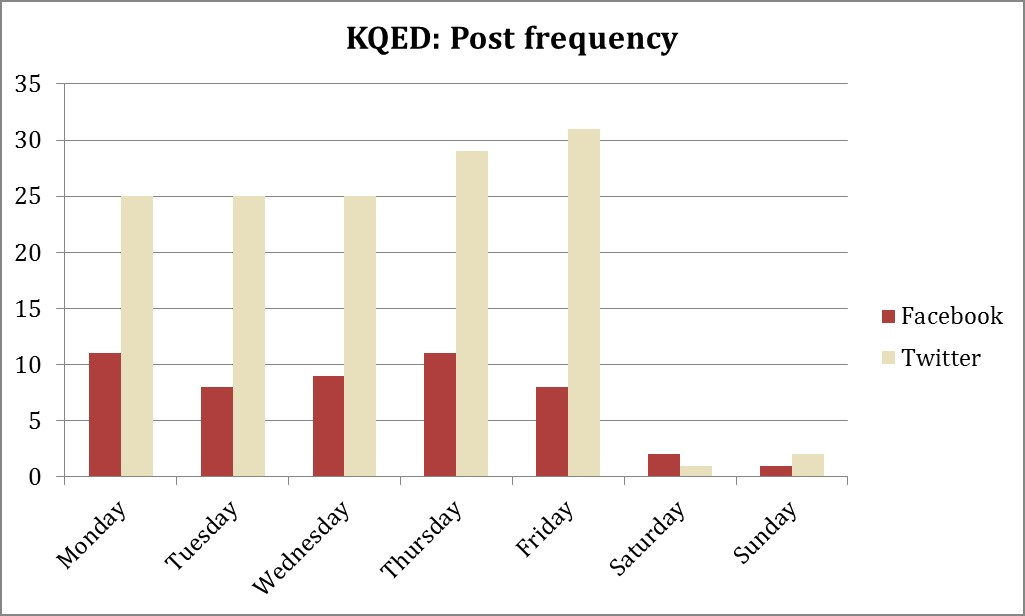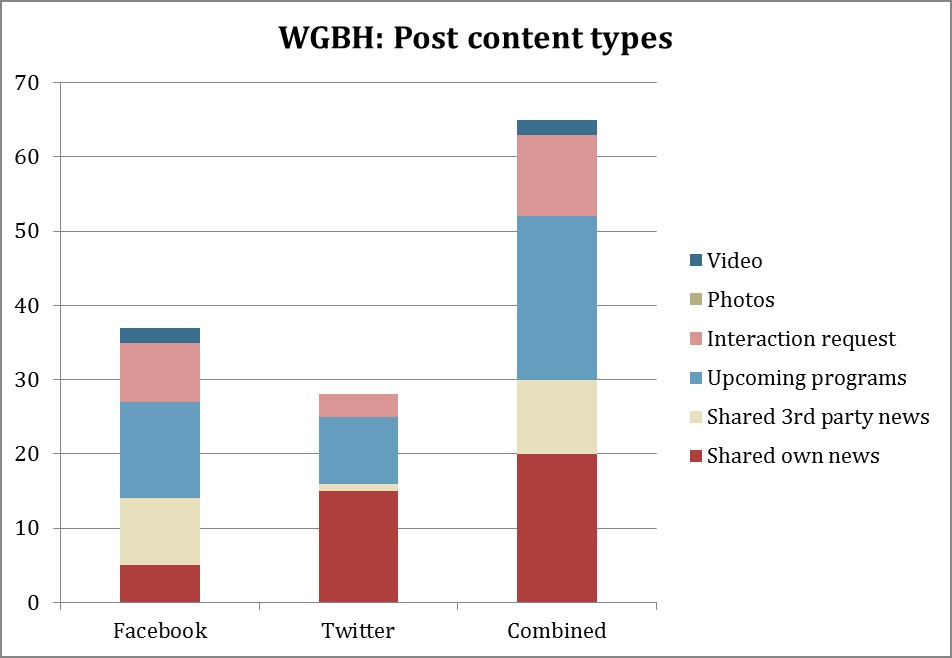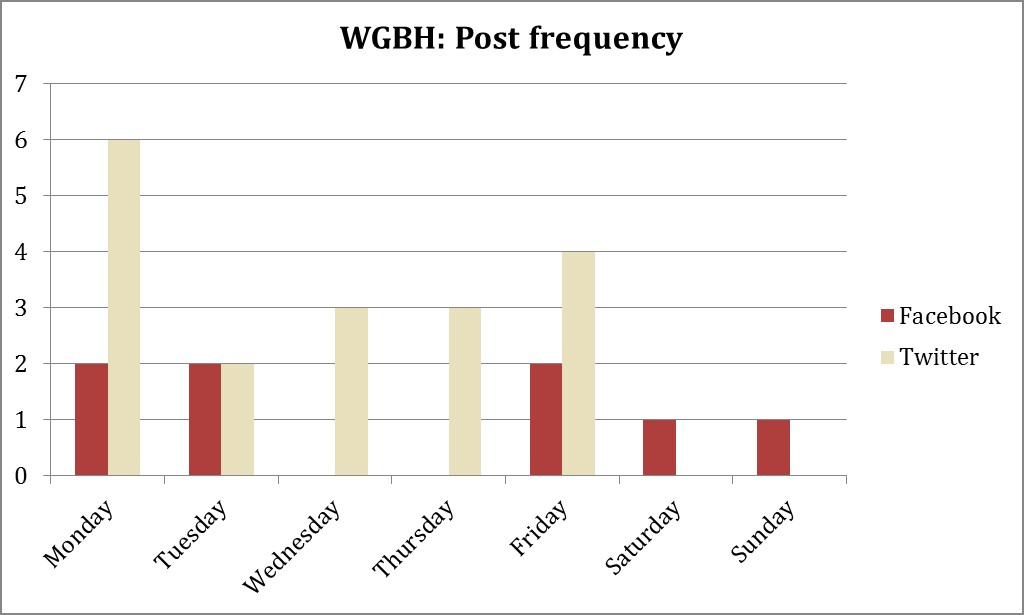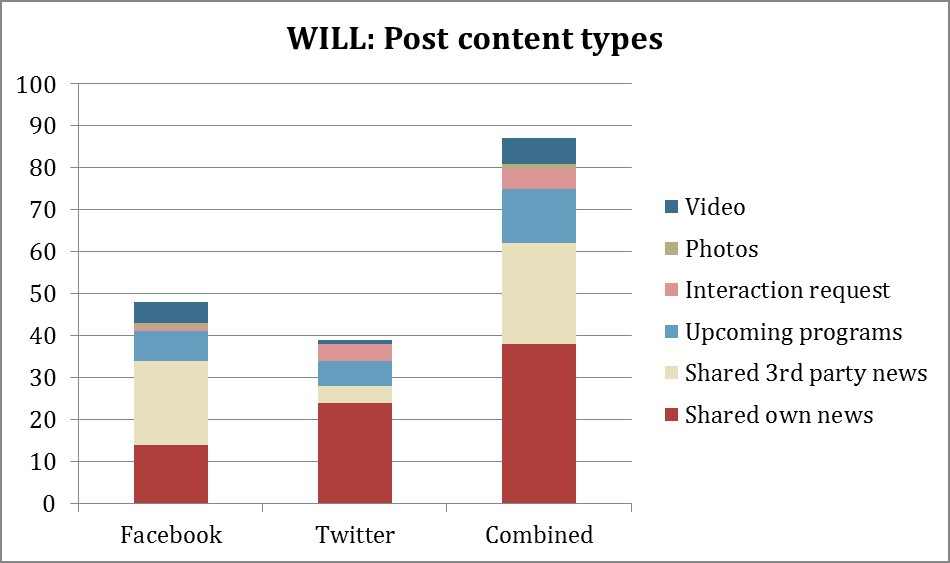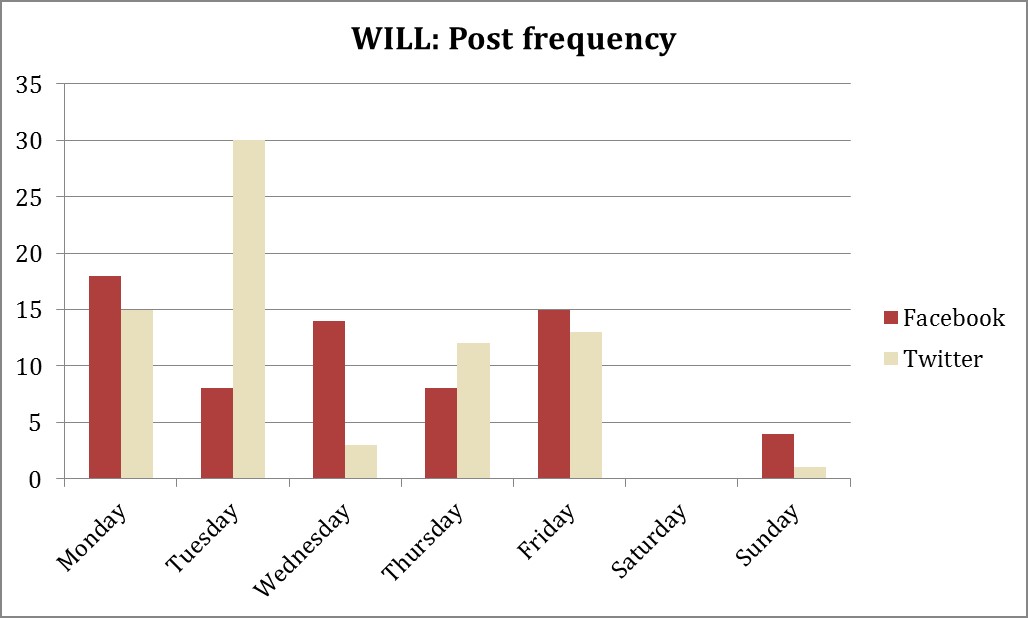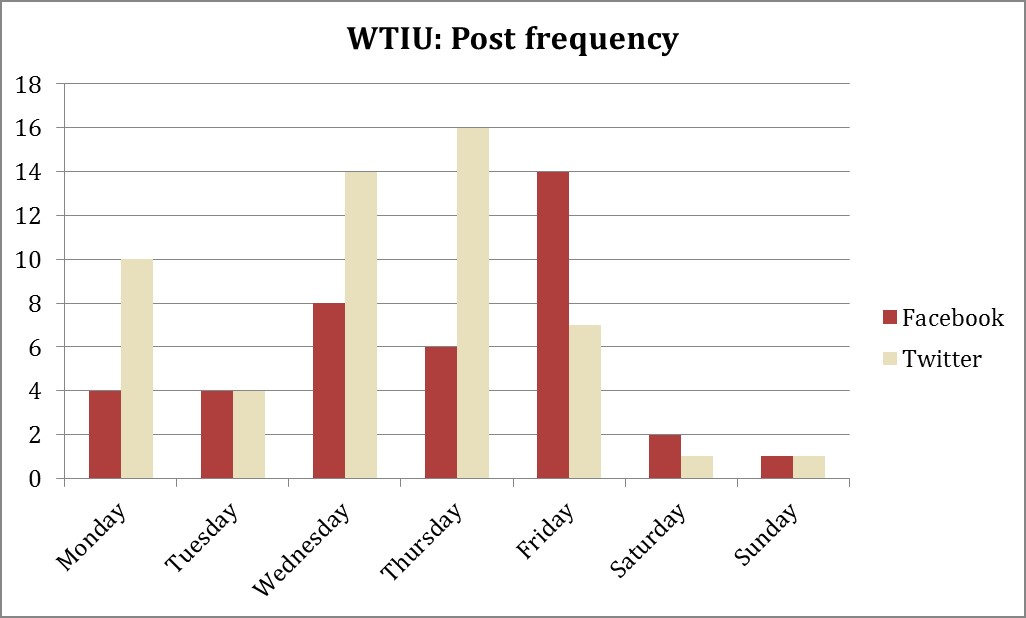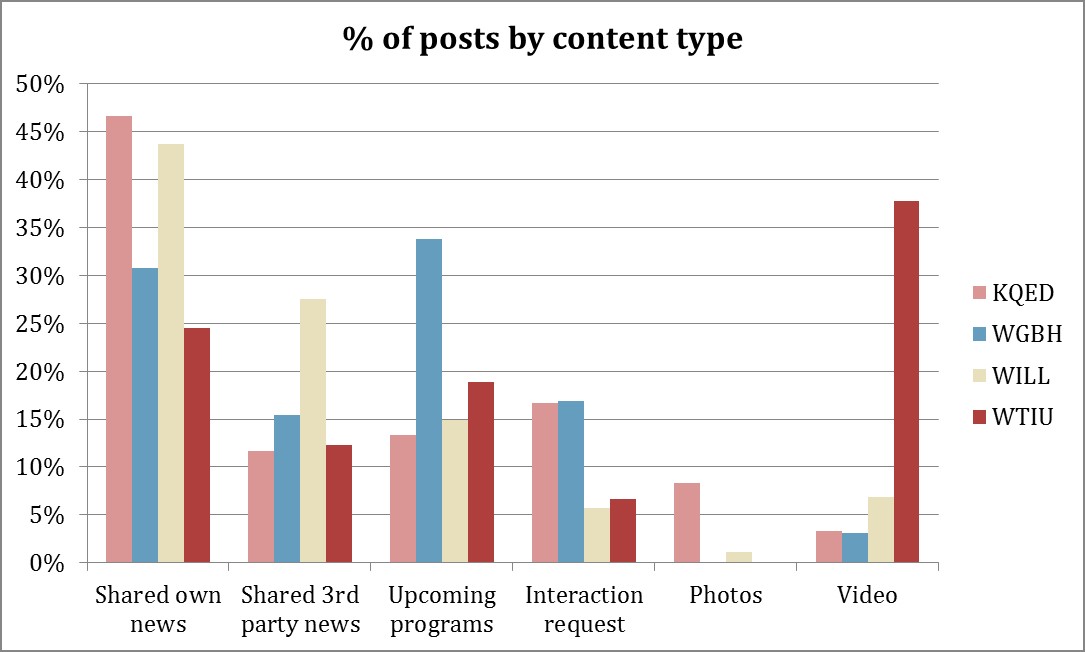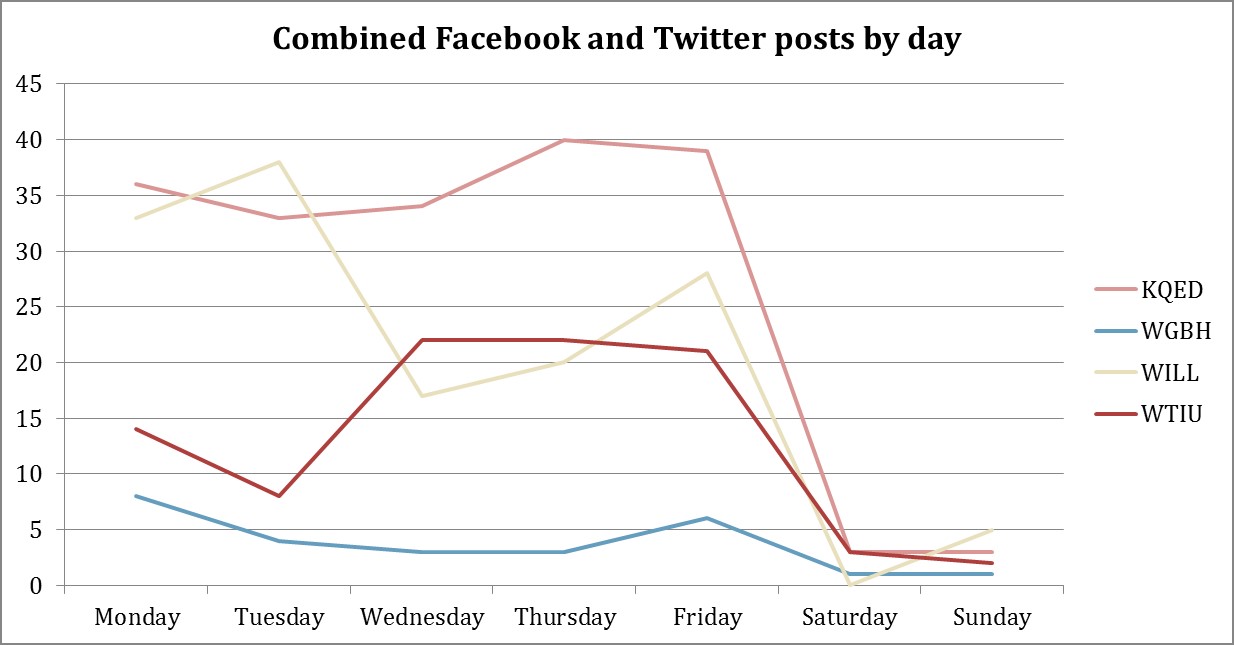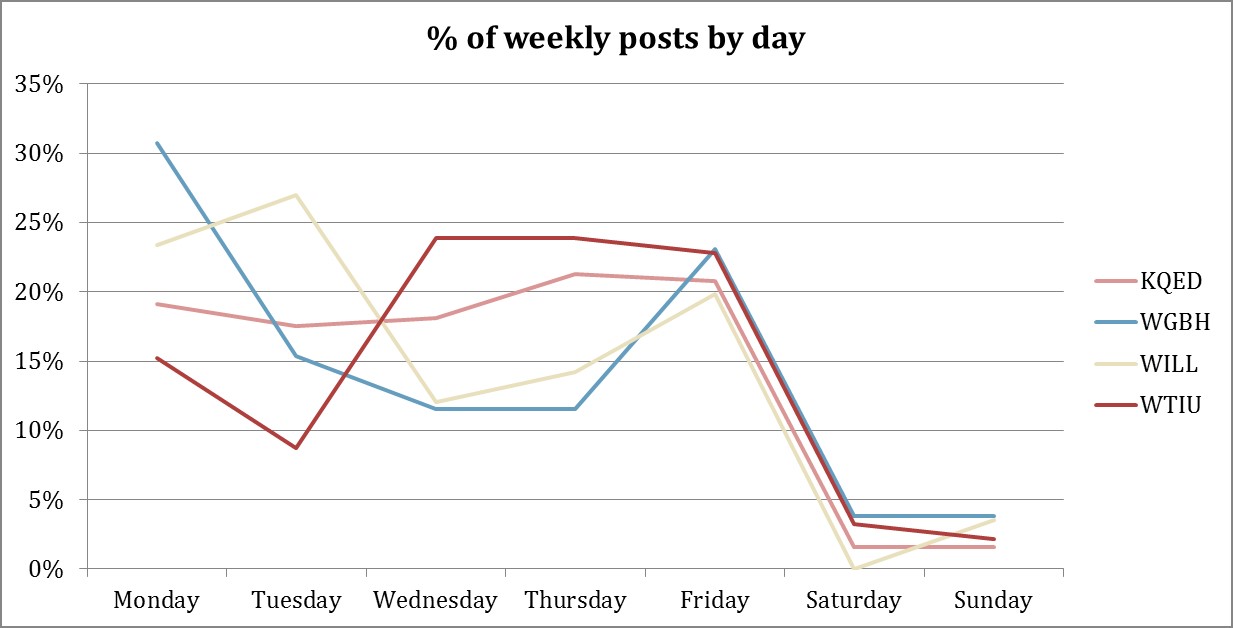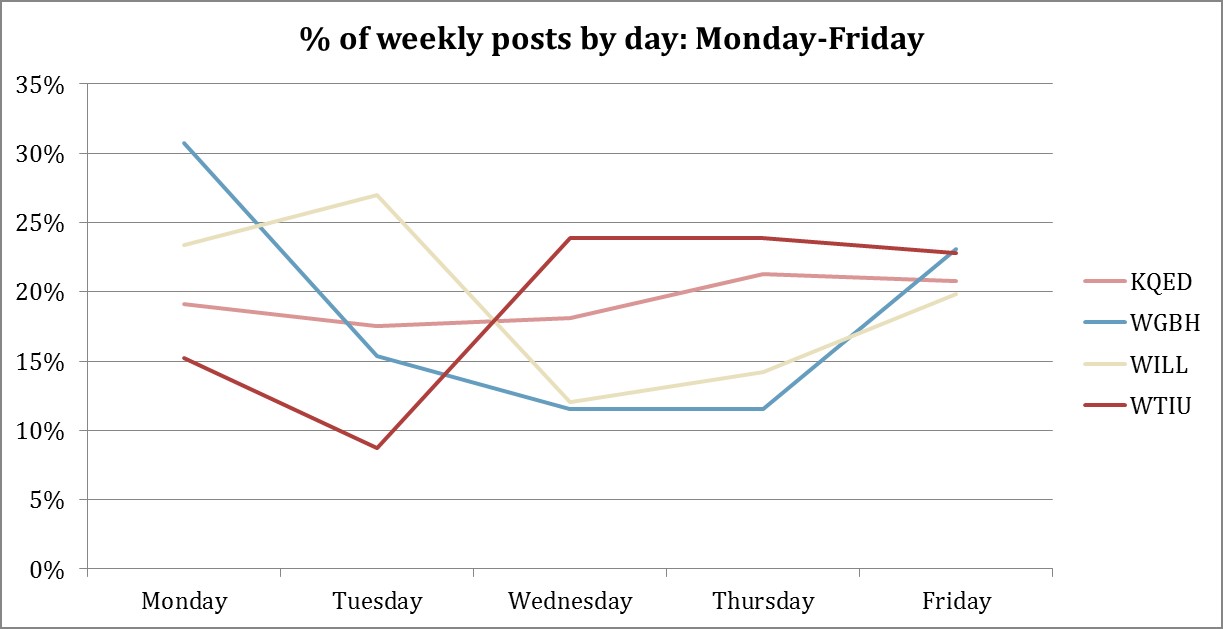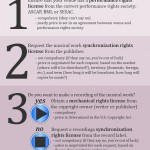While writing a social media strategy document for my local PBS station–WTIU–I did a case study comparing the social media presence and apparent strategy of four PBS affiliate stations.
Why you might read this: I know, it’s pretty long, but hey–there are lots of pretty graphs you can scan. It might give you ideas about how to look at your own (or your competitor’s content), and suggests that a variety of post topics combined with consistent, frequent posting leads to more followers. I looked at when these organization post to Facebook and Twitter, how often they do, how their interactions on Facebook compare to Twitter, and what types of content they post. The most interesting stuff (I think) is in the comparisons/implications section.
Case Study
Three Public Broadcasting Stations (television) were reviewed based on their representation of different sizes of audiences and apparent stages in their social media use (some seem to have a much more concrete strategy than others). A similar analysis of WTIU’s current activities was conducted for comparison.
To understand the types of content that were being shared on social media by these stations, the 30-50 most recent posts on Facebook and on Twitter were categorized into six groupings:
- Shared own news—news articles that linked back to the property’s own news site
- Shared third-party news
- Upcoming programs—posts that dealt in some way with programs airing on the station
- Interaction requests—a poll, giveaway, event notice or some other post that asked users to respond/enter/attend
- Photos
- Videos
To gain a sense of frequency, consistency, and how updates to Facebook compared to updates on Twitter, the number of posts was tallied per day during one week of observation (week of November 20, 2011).
KQED Television, Northern California
KQED public media is based out of San Francisco and serves a large area of Northern California, claiming a weekly audience of over three million (combined on air and online).[1] As a station that produces much of its own programs, covers a large audience, and is seated in the heart of one of the largest concentrations of technology companies in America, KQED was identified as a station that may have a well-established and successful social media strategy.
From KQED’s website (http://www.kqed.org/), users can find links to their Facebook and Twitter pages in the header of every page as well as a large “Community” section that includes new media content (like blogs and maps that complement programming) as well as a dedicated “Social Media” page that links users to accounts including eight YouTube channels and seven Flickr groups.
KQED also lists eight Facebook pages differentiated by content: one page for news, pages for top locally-produced programs, and an overarching general page. The general KQED Facebook page had 13,394 likes and 394 people “talking about this” during the week surveyed. This page has a custom front page that featured a large “like” call-to-action, a giveaway notice and link to the website, a “donate now” button that linked to a donation form on the website, and a call to sign up for monthly email newsletters.
The station has even more Twitter accounts, 12 in fact, that include accounts for local programs, interest areas (KQED News, KQED Arts, KQED Food, etc.), and a general umbrella account (@KQED). The general Twitter account had 11,394 followers, followed 978 accounts and had posted 9,978 tweets (it is interesting to note that the account gained 761 new followers by early December and grew much faster than the Facebook account, which acquired 406 more likes in the same time).
The tone of both accounts was straightforward and humorous at times, with comments on posts like, “Another sixth-grader who will make you feel like you haven’t done anything with your life.” Both accounts seem to be managed by Hootsuite (Facebook posts certainly were), and posts to Twitter nearly tripled the amount of posts to Facebook during the week surveyed.
The majority of posts on both Facebook and Twitter concerned news shared from KQED’s own news site, followed by interaction requests and programming information on Facebook, while Twitter contained more of a balance between the remaining content categories.
KQED had a very balanced amount of posts per day on both accounts, and as the chart shows posts to Twitter doubled and sometimes nearly tripled posts to Facebook during the week. On average, KQED posts seven times a day to Facebook and 20 times a day on Twitter. The drop in posts over the weekend is a trend that is consistent across all of the organizations examined, and follows research that suggests users check social media less over the weekend than during the work week.[2]
From the high number of connections through social media, a balanced mix of content and a steady schedule of posts, KQED may have a model social media strategy that seems to be successful.
WGBH Television, Boston
As one of the most-recognizable PBS stations thanks to its production of some of the most popular national programs, WGBH was identified as a station whose social media strategy may be well-thought out. Local viewership is stated at 2.5 million TV viewers and over 400,000 online visitors per month, but the audience for its programs likely includes most of the national public television audience.[3]
WGBH’s Facebook page had garnered 8,333 likes, with 152 people “talking about this” at the time of the review, while their Twitter page showed 6,997 followers, 5,129 accounts followed and 3,638 tweets. At least four Twitter accounts existed in addition to the general @WGBHboston, including one news account and profiles for top programs.
The amount of updates between WGBH’s Facebook and Twitter accounts are much more sporadic than KQED’s, which may mean that their social media strategy is not focused on consistency of updates. It may also be a factor of the availability of content to update with: as tweets most often contained links to news written by WGBH or programming information, it may be easier to consistently have something to share with users than the broader range of topics covered on the Facebook page. Finally, while WGBH posts about the same amount per day on Facebook (one) and Twitter (three), their overall average number of posts is much lower than all of the other stations reviewed.
WILL Television, University of Illinois at Urbana-Champaign
The University of Illinois’ public television station was reviewed as a smaller station whose organization is similar to WTIU’s—a station owned by a large public university. A 2010 Nielsen report quoted on the WILL-TV website states that the weekly household cume (cumulative measure of unique households watching in a week) for WILL was 83,000.[4]
The WILL website links users to social network accounts (Facebook, YouTube, Flickr and Twitter) prominently and persistently in the right-hand navigation on every page.
WILL’s social media updates seem to be rather balanced across Facebook and Twitter, with a fair amount of shared self-produced news (more so on Twitter than Facebook), shared third-party news (more heavily on Facebook than Twitter), and some representation from each of the remaining categories. Aligning more with KQED’s content mix than WGBH’s, information on upcoming programming is not the focus of many social media posts for WILL.
Overall, WILL’s social media post frequency seems more balanced than WGBH’s, but is not as even as KQED’s. Some (but not all) days had more posts on Twitter than Facebook, but there is no consistent pattern apparent for the week reviewed. The number of posts per day averaged out to 10 on Facebook and 11 on Twitter.
WTIU
The placement of social media links on WTIU’s website is similar to WILL’s, with a dedicated area on the right-side navigation that is persistent across top-level navigation (home, radio, tv, news, arts & music, kids & families, and events). All of the icons except for Flickr open a shadow box that lists “subscription options,” allowing users to choose from RSS feeds related to programs, four Facebook pages, three YouTube channels, six Twitter accounts or one Flickr page. The right-side navigation is not persistent through second-level pages on the ‘TV’ section, as many of the pages have a unique look and structure, and a few take users out of the Indiana Public Media group of sites altogether (such as Watch Video, Community, and Support—likely necessitated by functionality and the location of content).
At the time of the review, the main WTIU Facebook page had 757 likes, with 15 people “talking about this.” Following the apparent trend of differentiating content, WTIU lists three additional Facebook pages—two local programs (The Friday Zone with 309 likes, and The Weekly Special with 399 likes), and one page dedicated to the 2010 election (160 likes, with the last post on May 3, 2011. Perhaps this should be removed or updated to the 2012 election.). There is also a dedicated page to Indiana Public Media News with 18 likes that is not listed on the website, it may be inactive at this point as mentioned earlier, and should be removed to avoid confusion if that is the case.
The main WTIU Twitter account had 779 followers, followed 144 accounts and had 1,064 tweets. Similar to KQED’s supplemental Twitter accounts, Indiana Public Media lists five accounts beyond @wtiu focused around interest areas: Arts & Culture (which leads to @wfiuarts, with 1,202 followers), Local News (@INPubMediaNews with 628 followers), Live Event Coverage (which seems to be a broken link), and an Indiana Election 2010 account (the last tweet to this account was in November 2010). Additionally, an umbrella Indiana Public Media account is listed (@INPublicMedia with 380 followers).
WTIU’s Twitter posts have a nice balance between the various content types, with the majority representing news produced in-house, while the Facebook page seems to be heavily populated by video clips.
The post frequency from WTIU is also well-balanced currently, although like WILL, some days saw more Facebook posts than Twitter while others saw the reverse. It may make sense to decide definitively how many posts on average should go to each account during the week, with a different goal for weekends, and whether one account should consistently have more posts than the other, or if it matters. The average posts per day for the week reviewed was six for Facebook and eight for Twitter.
Comparison and implications
By comparing results from all four stations, a few trends and suggestions for WTIU’s social media strategy may be found.
The above chart summarizes the percentage of all posts that fit into each of the six listed content types for each station. It seems that shared news produced by the station is the well-represented and should remain a large part of content posted on social media. Shared third-party news and programming information are the next-largest content types, with interaction requests following closely. As suggested earlier, a balance of these six content types should give users a variety of information in a number of formats, hopefully encouraging interaction and causing users to feel they are getting something valuable by connecting with WTIU through social media. It’s clear from this chart that WTIU posts far more videos than any other station, which may be an interesting differentiation as long as there is a clear reason why a video is being posted (not just for the sake of posting a video).
A comparison of the number of posts per day on both Facebook and Twitter by station shows that different stations are taking their own approach to social media, likely based on how it fits their audience and in-house resources. KQED is the most active on social media, followed by WILL with WTIU closely behind. It is interesting that WGBH, a large station that produces much of the national programming seen across the country, is the least active on social media.
If the graph is normalized to see what percentage of weekly posts occur on each day of the week, it seems there is a lot of variation between stations and the only consensus is that posts during the weekend are much lower than during the week.
KQED’s posts are the most even through the work week, and combined with the fact that they use Hootsuite at least to manage their Facebook updates, it may be inferred that this station has a schedule or a defined goal to have a more or less consistent number of posts per day. This reinforces the suggestion that WTIU follow a similar strategy of an even number of posts on weekdays.
By narrowing the goal for WTIU’s social media campaign, administrators can create a consistent tone and content strategy for posting on social networks. By following certain best practices, such as having a more or less consistent number of posts per day, and testing strategies to reach different target audiences, WTIU can find how to get the most out of social media while connecting with users in a meaningful way.
[1] “Who tunes in to KQED?” Sponsorship Frequently Asked Questions. KQED, n.d. Web. 10 December 2011. http://www.kqed.org/support/sponsorship/faq.jsp
[2] Smith-Robbins, Sarah. Personal interview. 3 October 2011.
[3] “Increase Your Visibility Before a Large and Loyal Audience.” WGBH. WGBH, September 2011. Web. 10 December 2011. http://sponsorship.wgbh.org/Reason_1.cfm
[4] “Business Support.” Illinois Public Media. Illinois Public Media, 2011. Web. 10 December 2011. http://will.illinois.edu/support/businesssupport/


